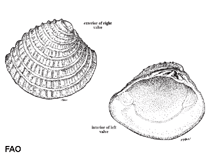Chione cancellata (Linnaeus, 1767)
Cross-barred venus
Classification / Names आम नाम | उपशब्द | CoL | ITIS | WoRMS
Bivalvia | Venerida | Veneridae
Environment: milieu / climate zone / गहराई सीमा / distribution range पारिस्थितिकी
; गहराई सीमा 2 - 2 m (संदर्भ 87155). Tropical; 27°C - 28°C (संदर्भ 87155)
Distribution देश | ऐफ ऐ ओ क्षेत्र | Ecosystems | संयोग | भूमिका
Western Atlantic: from Honduras to southeast Brazil.
Length at first maturity / आकार / Weight / Age
परिपक्व अवधि: Lm ? range ? - ? cm Max length : 2.5 cm DL पुल्लिंग / अलिंग; (संदर्भ 83435); common length : 4.5 cm TL पुल्लिंग / अलिंग; (संदर्भ 344); अधिकतम सूचित उम्र: 6 वर्षो (संदर्भ 2823)
Short description आकृति विज्ञान
Shell thick, trigonal. Sculpture of blade-like concentric ridges crossed by radial ribs. Interspaces between ribs smaller than between ridges. Lunule heart-shaped, dark. Colour: externally white to light grey, sometimes with brown rays, internally white, frequently with blue-purple markings.
Depth range from Belize (Ref. 87155). Sand in shallow subtidal environments, often in seagrass beds. Known from seamounts and knolls (Ref. 3477). Host of Pseudomyicola spinosus (Ref. 3477).
Life cycle and mating behavior परिपक्व अवधि | पुनरुत्पत्ति | मछलीऔ का अंडे देना | Eggs | Fecundity | Larvae
Members of the class Bivalvia are mostly gonochoric, some are protandric hermaphrodites. Life cycle: Embryos develop into free-swimming trocophore larvae, succeeded by the bivalve veliger, resembling a miniature clam.
Main reference
संदर्भ | संयोजक | सहयोगीयो
Leal, J.H. 2003. (संदर्भ 344)
IUCN Red List Status
(संदर्भ 130435: Version 2024-2)
CITES status (संदर्भ 108899)
Not Evaluated
CMS (संदर्भ 116361)
Not Evaluated
Threat to humans
Human uses
मात्स्यिकी: व्यापारिक
| FishSource |
साधन
अधिक जानकारी
Trophic Ecology
खाद्य पदार्थ
संघटक आहार
आहार खपत
Food rations
परभक्षी
संघटक आहार
आहार खपत
Food rations
परभक्षी
पारिस्थितिकी
Population dynamics
बाढ़
Max. ages / sizes
Length-weight rel.
Length-length rel.
Length-frequencies
Mass conversion
भर्ती
बहुतायत
Max. ages / sizes
Length-weight rel.
Length-length rel.
Length-frequencies
Mass conversion
भर्ती
बहुतायत
Life cycle
Distribution
इंटरनेट स्रोत
BHL | BOLD Systems | CISTI | DiscoverLife | FAO(Publication : search) | Fishipedia | GenBank (genome, nucleotide) | GloBI | Gomexsi | Google Books | Google Scholar | Google | PubMed | Tree of Life | Wikipedia (Go, खोज) | Zoological Record



